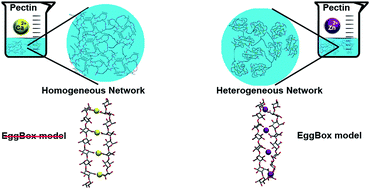Structural behaviour differences in low methoxy pectin solutions in the presence of divalent cations (Ca2+ and Zn2+): a process driven by the binding mechanism of the cation with the galacturonate unit†
Abstract
In this paper, we compare the interactions between low methoxy pectin (LMP) and either Ca2+ or Zn2+ in semi-dilute solutions. Intrinsic viscosity and turbidity measurements reveal that pectin–calcium solutions are more viscous, but yet less turbid, than pectin–zinc ones. To get a molecular understanding of the origin of this rather unexpected behavior, we further performed isothermal titration calorimetry, small angle neutron scattering experiments, as well as molecular dynamics simulations. Our results suggest that calcium cations induce the formation of a more homogeneous network of pectin than zinc cations do. The molecular dynamics simulations indicate that this difference could originate from the way the two cations bind to the galacturonate unit (Gal), the main component of LMP: zinc interacts with both carboxylate and hydroxyl groups of Gal, in a similar way to that described in the so-called egg-box model, whereas calcium only interacts with carboxylate groups. This different binding behavior seems to arise from the stronger interaction of water molecules with zinc than with calcium. Accordingly, galacturonate chains are more loosely associated with each other in the presence of Ca2+ than with Zn2+. This may improve their ability to form a gel, not only by dimerization, but also by the formation of point-like cross-links. Overall, our results show that zinc binds less easily to pectin than calcium does.


 Please wait while we load your content...
Please wait while we load your content...